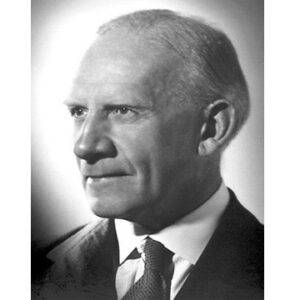Sir Robert Robinson was a British scientist who won the Nobel Prize and was knighted for his work on the structure and synthesis of natural elements, including pigments and alkaloids found in plants. He was a recognized expert in chemistry, synthesis, electronic theory, and a variety of other scientific fields. From his initial study of plant pigments, he was able to synthesize a large number of flavones and anthocyanins. He specialized in alkaloids and their intricate structures, which occur naturally and have biological and chemical effects on all living things. In 1925 and 1946, his research into the chemical reactions that occur in plants to form alkaloids led him to discover the structures of morphine and strychnine. His research resulted in the synthesis of penicillin and a number of other antimalarial drugs. Additionally, he was a proponent of the electron theory in organic chemistry, which was concerned with the structure of organic molecules. He contributed to the development of numerous new dyes used in the textile industry. He was also an inventor, having developed an automatic lint cutting machine during his youth. He was awarded the Order of Merit for his research in organic chemistry.
Childhood & Adolescence
Sir Robert Robinson was born on September 13, 1886 near Chesterfield, Derbyshire, United Kingdom, on the Rufford Farm. William Bradbury Robinson was his father, and Jane Davenport, William’s second wife, was his mother.
Robert was the eldest of his father’s five children from his second marriage. His father had ten children from his first marriage.
He began his education at a kindergarten in a town near Chesterfield. Following kindergarten, he attended the ‘Chesterfield Grammar School’ as a weekly boarder, where he developed an interest in mathematics.
He boarded at the ‘Fulneck School’ near Leeds in West Yorkshire when he was twelve years old. Robert was sent to ‘Manchester University’ in 1902 by his father to study chemistry, as chemists were in high demand in the textile industry.
In 1905, he graduated from ‘Manchester University’ at the top of his class (BSc with honors in chemistry). He joined Professor William H. Perkin’s organic chemistry department following graduation. In 1910, he received a DSc degree from the ‘Victoria University of Manchester.’
Career of Robert
Sir Robert Robinson arrived in Australia in 1912 to take up a position at the ‘University of Sydney’s’ Department of Pure and Applied Chemistry. He conducted research here on the synthesis of various ‘catechol’ derivatives, C-alkylations of enolates, and ‘eudesmin,’ a component of Australian Eucalyptus oil.
In 1914, he was invited to visit the ‘British Association for the Advancement of Science,’ where he met prominent British chemists such as H. E. Armstrong and Nevil V. Sidgwick.
He was appointed to the chair of Organic Chemistry at the University of Liverpool, UK, at the age of twenty-nine, as the youngest candidate. He returned to England with his wife during the First World War and resumed his duties at the university in January 1916.
Soon after, he was asked, like all other chemists, to assist in the war effort by assisting in the manufacture of picric acid, TNT, Tropinone, morphine, and odeine.
In 1917, he co-founded the ‘Advisory Board’ with other prominent chemists to develop natural resources, where he invented a new method for synthesizing synthetic ‘octanol.’
He was once enlisted by the authorities of Liverpool Harbor to assist them in extinguishing a fire caused by burning oil. Rather than charging a personal fee, he requested that the funds be donated to the university library.
In 1920, he resigned from his position as Professor of Chemistry at the University of Liverpool to become Director of Research for the ‘British Dyestuffs Corporation.’
In 1921, he decided to return to academia and applied for and was appointed to the recently vacated chair at St. Andrews in Scotland.
In 1922, the chair of organic chemistry at the University of Manchester became vacant, and he left St. Andrews after only one year to fill it.
He collaborated with a large number of young researchers there and worked on plant-derived pigments. From 1925, he collaborated with his wife Gertrude on the process of fatty acid synthesis. He accepted a professorship at the University of London in 1928.
He was appointed ‘Waynflete Professor’ of chemistry at Oxford University in 1930 and served until 1955. In 1947, he was appointed as the UK’s delegate to the UNESCO conference and was asked to deliver the Royal Society’s presidential address that year.
He was named ‘Emeritus Professor and Honorary Fellow’ of ‘Magdalen College’ in 1955. From 1955, he served as a director of the ‘Shell Chemical Company.’
Awards and Accomplishments
In 1920, he was elected a ‘Fellow of the Royal Society.’ In 1921, he was elected to the ‘Chemical Society’s’ council.
In 1939, he was knighted. In 1947, he was awarded the Nobel Prize in chemistry for his research on alkaloids. In 1949, he was awarded the Order of Merit.
Personal History and Legacies
On August 7, 1912, he married Gertrude Maud Walsh, a fellow Manchester student. In 1914, he gave birth to his first daughter, but she died after only one day. Marion, their second daughter, was born in 1921, followed by a son a year later.
In 1957, following Gertrude’s death in 1954, he married Stearn Sylvia Hillstrom. Sir Robert Robinson died in London, United Kingdom, on February 8, 1975.
Estimated Net Worth
Rob Robinson is one of the wealthiest American football players and is ranked among the most popular. Rob Robinson’s net worth is estimated to be around $35 million, based on our analysis of Wikipedia, Forbes, and Business Insider.
Trivia
Sir Robert Robinson was an avid chess player and a natural mountaineer. He had climbed numerous peaks throughout Europe and New Zealand.


